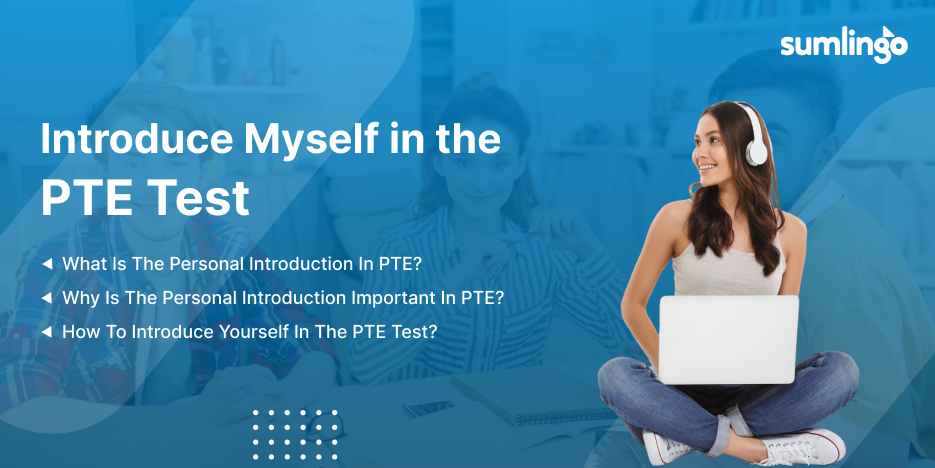The PTE Academic test does not have a dedicated “Introduction” section where test-takers formally introduce themselves. However, at the beginning of the speaking test, they will
encounter the Personal Introduction segment. While this section is not scored, it plays an important role in checking the identity of the test taker.
What is the Personal Introduction in PTE?
Before the test officially begins, you will be given 25 seconds to prepare and 30 seconds to record your Personal Introduction. This recording is not assessed, but it may be sent to the institutions you are applying to.
Why is the Personal Introduction important in PTE?
Although Personal Introduction is not marked in the exam, it plays an important role for the following reasons:
- The recorded introduction of test-takers may be sent to universities to evaluate speaking abilities.
- It acts as a warm-up question which reduces nervousness and allows the test taker to settle for the speaking section.
How to Introduce Yourself in the PTE Test?
A simple and structured approach can make introduction more effective. Here’s a sample step-by-step format that test takers can follow:
1. Your Name and Background
- Start by stating your name and where you are from.
- Example: Hello, my name is [Your Name], and I am from [Your Country/City].
2. Your Interests
- Mention any hobbies or fields of interest.
- Example: I have a keen interest in technology and enjoy learning about artificial intelligence.
3. Your Future Study Plans
- Explain what you plan to study and where.
- Example: I have completed my Bachelor’s in Computer Science, and I plan to pursue a Master’s in Data Science in Australia.
4. Why You Want to Study Abroad
- Talk about your motivation for studying in another country.
- Example: Studying abroad will give me access to world-class education and help me gain global exposure.
5. Why You Need to Learn English
- Explain why English is essential for your goals.
- Example: I need strong English skills to communicate effectively in academic and professional settings.
6. Why You Chose the PTE Test
- Give a reason for selecting PTE over other tests.
- Example: I chose PTE Academic because of its computer-based evaluation, unbiased scoring, and fast results.
Sample Response:
- My name is Priya Sharma. I have recently completed my Bachelor’s degree in Computer Science, and I want to pursue a Master’s in Data Science in Australia. My hobbies is listening to music. I chose the PTE test because it gives a fair evaluation.
- My name is Raj. I work as a marketing executive. I want to pursue an MBA in Canada to grow in my career. I enjoy reading business books and love travelling. I chose the PTE test because it’s an unbiased test.
Are you ready to test your skills?
Tips for a Strong Personal Introduction
1. Speak Clearly & Naturally
- One of the biggest mistakes test-takers make is speaking too fast or too slow. Speaking at a natural pace ensures clarity and makes it easier for others to understand. They should not rush through their sentences instead of they should focus on pronouncing words correctly and maintaining a steady rhythm.
- Tip: Test taker should practice with a voice recorder, listen to their speech and make improvements in pronunciation and fluency.
2. Use Simple and Correct Grammar
- In PTE exam, introduction should be easy to understand and free of grammatical mistakes. Test takers should not use complicated sentences or unfamiliar vocabulary which can lead to errors and hesitation. They must stick to simple, well- structured sentences to avoid hesitations.
Example:
I have recently completed my Bachelor’s degree in Business Administration, and I to pursue a Master’s in Marketing in Australia.
3. Maintain a Confident Tone
- Confidence plays a major role in the exam. Even if a test taker is feeling nervous, they should try to sound calm and composed. A confident introduction can help you get comfortable with speaking in English before the test officially begins.
4. Practice Beforehand
- Test taker must practice their introduction multiple times which will make them more fluent and confident on test day.They should practice in front of a mirror, record themselves, or practice with a friend. The more comfortable they will feel with your introduction, the easier it will be to deliver it smoothly.
5. Avoid Long Pauses
- A common mistake is pausing too much or using filler words (like umm, ahh, you know). While short pauses are natural, excessive hesitations can make test takers’ introduction sound unprepared.
6. Stay Within the Time Limit
- Test takers must have 25 seconds to prepare and 30 seconds to speak, so time management is crucial. If they speak too slowly, their time might run out of time before finishing. If they speak too fast, their introduction may sound rushed and unclear.
Practice with Sumlingo’s PTE Mock Tests and Practice Tests
With Sumlingo AI- drive practice test or mock tests will help the test takers to improve their score and confidence before the actual pte exam.
- Practice speaking fluently in a real time test environment.
- Get Instant AI Scoring after completing of the tests.
- Get access to sample answers to identify mistakes and make improvements.
Try a pte academic mock test free on Sumlingo and improve your score effortlessly!










